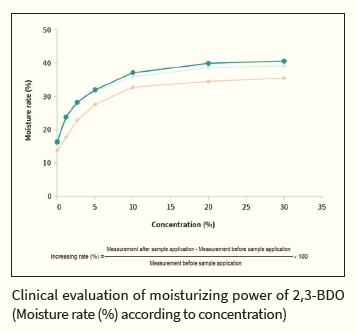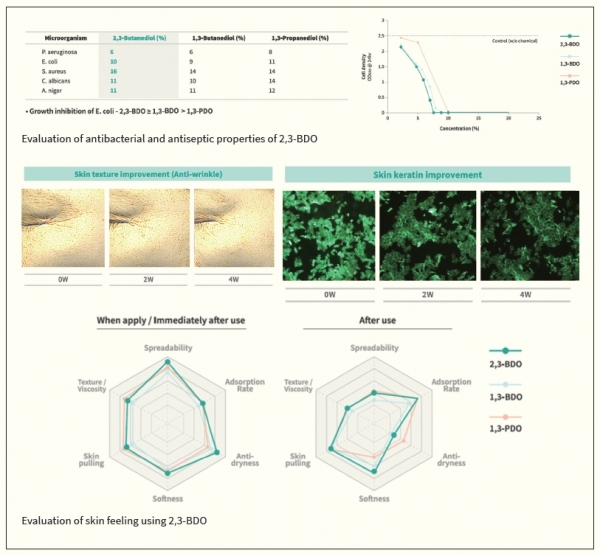Jong-myung, Park
Principal Researcher/ GS Caltex Technology Research Institute
Ⅰ Introduction
The film " Interstellar" , released in 2014, depicts a futuristic world with sandy, dusty winds that make breathing difficult and corn, the only source of food, is in danger of disappearing. However, watching the increasing concentration of particulate matter through the news and the internet every day, and difficulty in seeing a clear sky, it seems that the story in the movie is coming to reality. With the Industrial Revolution, mankind has grown and prospered in a short time, but nowadays other organisms and Earth itself are jeopardized as a result. As such, a new paradigm is required for the coexistence of the global environment and human prosperity. Sustainability and eco-friendliness are becoming keywords in the industry. For example, L'Oreal, the top cosmetics company in the world, launched a new campaign called 'Sharing Beauty with All' in 2013. It is a crucial campaign to improve sustainability in all aspects of our business, and by 2020 L'Oreal have aimed to make all its new products environmentally friendly. One of the new and well-noted paradigms is the biochemical industry. The biochemical industry is composed of biopharmaceuticals, bioagriculture, fusion biotechnology, and other biotechnology industries. Unlike the existing chemical industry based on fossil fuels, biomass is used as a renewable raw material that can be used in biological processes and chemical processes based on biological processes to produce various chemical products. The biochemical industry is unique in its emphasis on being environmentally friendly.

Looking at the trends in the biochemical industry, the recent low oil prices have increased interested in high value-added " Specialty chemicals" as they are able to differentiate products from "Drop-in chemica"l products that have to compete with petrochemical products. Global petrochemical companies are establishing strategic partnerships with bio-companies and commercializing them. Dow and Cargill have established Natureworks to produce bio-based PLApolylactic acid at 140,000 tons per year, of which about 3.2% (4,500 tons) are imported and used domestically.
Dupont has commercialized corn-based 1,3-propanediol 1,3-PDO production in collaboration with Tate & Lyle and has expanded its plant to about 64,000 tonnes in 2011. 1,3-PDO is used in textile materials (PTT, poly trimethylene terephthalate), cosmetic raw materials and food materials. Because of the active movement of global petrochemical companies and government support, the World Economic Forum predicted that biochemistry would account for 9% of the global chemical market by 2020. GS Caltex has been making continuous efforts for 10 years to create an ecosystem for the domestic biochemical industry based on its vision of 'Value No.1 Energy & Chemical Partner' . GS Bio, a subsidiary, produces and supplies commercial biodiesel. GS Caltex is spurring research and development for the industrial production of bio-2,3-butanediol2,3-BDO and biobutanol. Among them, 2,3-BDO is notable for its production, as well as its efficacy and applications, as 2,3-BDO is a high valueadded specialty chemical product and a natural cosmetics raw material. 2,3-BDO produced by GS Caltex is one of the raw materials that best meet the Mega Trend, where " Sustainability" is a keyword. It also has especially appropriate applications given the recent Trend favoring naturally-occurring and eco-friendly materials. GS Caltex has built a 2,3-BDO demonstration plant with a production capacity of 300 tonnes/year on a 25500 m2 site in the Gunsan Saemangeum National Industrial Complex.

Ⅱ What is 2,3-BDO?
2,3-BDO, which is a safe chemical in nature, is a C4 chemical and its molecular formula is C4H10O2. It naturally exists in three isomeric forms: (2R,3S)-, (2R,3R)-, (2S,3S)-form (ormeso-, levo-, dextro-form) because of the two–OH groups attached to the carbon. 2,3-BDO can be applied as raw material for cosmetics because of its antibacterial properties and moisturizing abilities. It can also be used as a natural solvent or preservative for natural product extraction. In addition, it can be used for polymer synthesis, serve as raw material for rubber, be used as a food additive, and serve as an industrial solvent and the like because it promotes growth and drought resistance when treated with plants and is also effective in preventing disease. The following manuscript introduces 2,3-BDO as a raw material for cosmetics.
Ⅲ Why 2,3-BDO? – Sustainability (Natural & Bio-based)
2,3-BDO is the only butanediol that exists in nature as a natural product that is also applicable to cosmetics. There are microorganisms that produce 2,3-BDO everywhere in nature, and 2,3-BDO is also present in the foods we consume. In particular, fermented foods produced by microorganisms such as wine, beer, makgeolli, miso, soy sauce, and kimchi contain 2,3-BDO. This is because most of the microorganisms used for fermentation of these foods produce 2,3-BDO in addition to lactic acid and ethanol. In other words, 2,3-BDO is a safe natural substance that exists widely in food and nature.

GS Caltex produces 2,3-BDO through eco-friendly bioprocessing. Due to its structural characteristics, 2,3-BDO is one of the few materials that is advantageous to produce through biological, rather than through petrochemical, processes. The petrochemical process can also produce 2,3-BDO, but it is a complex process at high temperature and high pressure and the process cannot selectively produce a single isomer, resulting in a high cost of separation and purification. For these reasons, mass production is difficult and 2,3-BDO has not been commercialized worldwide yet.
However, since the biological process at room temperature and pressure is simpler than the petrochemical process and the desired 2,3-BDO isomer can be selectively produced, economical and environmentally friendly production is possible compared with the petrochemical process. Microorganisms (biocatalysts), which act as catalysts in petrochemical processes, are more sophisticated than chemical catalysts and can selectively produce specific isomers.
GS Caltex has been able to produce 2,3-BDO economically by carrying out research and development for 10 years. It uses biomass feedstock (cassava or sugar cane) that is non-GMOGenetically Modified Organism. Because it has to be used as a raw material for cosmetics, no GMOs are applied to the production process, and the pathway for the production of 2,3-BDO from the raw material is a natural metabolic pathway rather than an artificial pathway. In addition, high-purity 2,3-BDO is produced just by applying physical methods such as ion exchange and distillation to the separation and purification process without using harmful substances such as solvents. Unlike petrochemical processes, isomers can be produced separately, and GS Caltex can produce (2R,3S)-BDO and (2R,3R)-BDO. The 2,3-BDO produced by GS Caltex is certified as a ' USDA Certified Bio-based Product' that is 100% naturally derived. In addition, EUREACH registration is underway to enter the European market, and COSMOS, an ecofriendly cosmetic raw material certification, will be completed by 2019. In addition to these, various certifications/registrations will be carried out.

Ⅳ Why 2,3-BDO? – Safety
2,3-BDO is registered in INCIInternational Nomenclature Cosmetic Ingredient, which recognizes it as an international cosmetic ingredient name, as well as in IECICInventory of Existing Cosmetic Ingredients in China, which is a list of Chinese cosmetic ingredients. Even though 2,3-BDO is a safe substance in food and in nature, a variety of safety tests have been conducted to offer empirical data supporting its safety. Since animal testing is prohibited for cosmetic raw materials, in vitro tests using no animals have been carried out for eye irritation, skin irritation, skin sensitization, genotoxicity, and phototoxicity. The results show that 2,3-BDO is harmless to humans and the environment. In addition, safety data were obtained through KOSHA Korea Occupational Safety & Health Agency and EUREACH.
Analysis by accredited institutions confirmed that no toxic substances such as heavy metals, parabens, formaldehyde, methanol, and phthalates were detected in the 2,3-BDO produced by GS Caltex.
Ⅴ Why 2,3-BDO? – Efficacy
2,3-BDO can be applied as a moisturizing agent as a raw material for cosmetics, and it also helps with antiseptic functions. In addition, it can serve as a basic solvent for dissolving various cosmetic ingredients and controlling viscosity. Various experiments were conducted to reveal the efficacy of 2,3-BDO as a raw material for cosmetics. First, we examined the change of skin moisture content by 2,3-BDO in concentration or timedependent manners in order to examine the moisturizing power through clinical evaluation. Diols such as 1,3-butanediol(1,3-butylene glycol, 1,3-BDO) and 1,3-PDO, which are currently used as raw materials for cosmetics, were also compared and evaluated. The results confirm that the moisture level was statistically equivalent to that of the existing raw materials.
We confirmed that 2,3-BDO can help preserve cosmetics through MICMinimum Inhibitory Concentration test and Challenge test. MIC is the minimum concentration at which a given substance can inhibit the growth of microorganisms. As a result, it was confirmed that the 2,3-BDO could inhibit this growth at a concentration of 16% or more. When applied to Escherichia coli microorganisms and further observing inhibition at different times/concentrations, it was confirmed that its efficacy is equivalent to or better than that of 1,3-BDO and 1,3-PDO, which are raw materials of cosmetics. The experiment was carried out with Challenge Test (observing the level of antisepsis of the cosmetics over a given time after injection of microorganisms) by applying an essence cream containing 2,3-BDO. The results show that the 2,3-BDO helped preventing the cosmetics from being spoiled by the microorganisms, suggesting that the amount of preservatives can be reduced.

2,3-BDO was applied to an essence cream to evaluate whether it improves the skin regarding wrinkles and stratum corneum, and how it feels when applied to skin. The results show that when the cosmetic with 2,3-BDO was applied to the skin and observed for 4 weeks, the wrinkles and the stratum corneum were improved. Compared with 1,3-BDO and 1,3-PDO, which are raw materials for cosmetics, we can confirm that there is a difference in how the cosmetics feel when applied on and absorbed by the skin.
We are continuing to evaluate the efficacy of 2,3-BDO in order to expand the market by discovering additional benefits of 2,3-BDO. A literature review suggests that 2,3-BDO regulates the expression of inflammatory factors such as TNF-α and IL-8, which will be further evaluated in future research.
In addition, 2,3-BDO could be used as a solvent or a preservative for natural product extraction. The efficacy of 2,3-BDO as an extraction solvent was confirmed, and it can be applied as a preservative if the MIC and the antiseptic test results show that the concentration is more than 20%. If 2,3-BDO, a natural product that is not a conventional petrochemical-derived substance, is used as an extraction solvent or preservative, it will be a true 100% natural product and will have a ripple effect on the market.

Ⅵ Conclusion
2,3-BDO produced by GS Caltex is the most suitable material for the Mega Trend represented by keywords such as sustainability, environment-friendly, safe chemical substances. Due to the characteristics of the cosmetics market, the need for such a Mega Trend was great. As such, it could be applied as cosmetic raw materials first. In order to enter the market as a new cosmetic raw material, we have communicated with various cosmetics and cosmetics raw materials companies for many years. Through this, the current bio-production process has been established and various safety evaluations, efficacy evaluations, certification, and registration that the market requires have been carried out.

